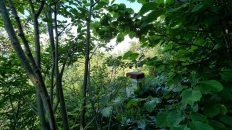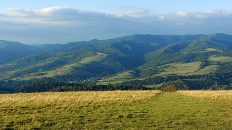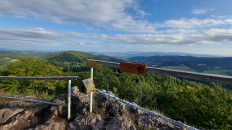🇵🇱
🚶 Wirtualna wędrówka: Wejście na Smerekową przez Dolinę Białej Wody, Polska
🏞️ Trasa: Jaworki, Biała Woda (602 m n.p.m.; 49.405989, 20.566771) – Rezerwat Biała Woda (617 m n.p.m.; 49.403474, 20.572025) – Przełęcz Rozdziela (803 m n.p.m.; 49.390373, 20.601511) – Wierchliczka (964 m n.p.m.; 49.383036, 20.592150) – Smerekowa (1014 m n.p.m.; 49.375419, 20.577017)
🆔 Oznaczenie: żółty szlak, niebieski szlak
📏 Długość: około 6,9 km
⏲️ Czas przejścia: około 2:30 h
↗️ Suma podejść: 497 m
↘️ Suma zejść: 85 m
00:00:23 Jaworki, Biała Woda
00:07:19 Skrzyżowanie szlaku czerwonego ze szlakiem żółtym
00:07:41 Rezerwat Biała Woda
00:08:23 Potok Biała Woda
00:09:56 Potok Biała Woda
00:12:03 Potok Biała Woda
00:14:30 Potok Biała Woda
00:22:27 Wodospad
00:26:47 Potok Biała Woda
00:36:11 Potok Biała Woda
01:03:44 Skrzyżowanie szlaku żółtego i niebieskiego
01:06:14 Skrzyżowanie żółtego i niebieskiego szlaku
01:12:06 Przełęcz Rozdziela
01:27:01 Zejście ze szlaku
01:29:53 Wierchliczka
01:33:27 Powrót na niebieski szlak
02:03:00 Zejście ze szlaku
02:11:32 Smerekowa
Pieniny – pasmo górskie położone w południowej Polsce i północnej Słowacji. Od południa Pieniny graniczą z pasmem Magury Spiskiej, od północy z Gorcami i Beskidem Sądeckim, na zachodzie zaś – z Kotliną Orawsko-Nowotarską oraz Pogórzem Spisko-Gubałowskim. Dzielą się na trzy części: Pieniny Spiskie, Pieniny Właściwe i Małe Pieniny. Najwyższe szczyty to Wysoka (1050 m), Jaworzyna (1016 m), Smerekowa (1014 m).
Skały budujące Pieniny powstały na dnie mórz w kilku epokach geologicznych. W górnej kredzie zostały sfałdowane i wydźwignięte. Na początku trzeciorzędu nastąpiła druga fala ruchów tektonicznych powodująca kolejne przesunięcia płaszczowin. Trzecia fala ruchów górotwórczych w okresie paleogenu i neogenu spowodowała powstanie bardzo skomplikowanej struktury tektonicznej pasa skałkowego. Równocześnie zachodząca erozja zdarła zewnętrzny płaszcz skał i wymodelowała skomplikowaną rzeźbę terenu. Szczyty i turnie zbudowane są z odpornych na wietrzenie skał jurajskich, głównie wapieni rogowcowych, bulastych i krynoidowych. Doliny i przełęcze powstały w miękkich i podatnych na wietrzenie skałach z okresu kredy i paleogenu.
Krajobraz Pienin tworzą strzeliste szczyty i głęboko wcięte wąwozy porozdzielane rozległymi halami pasterskimi.
Smerekowa (Vysoká) – szczyt o wysokości 1014 m n.p.m. w Pieninach. Jest trzecim co do wysokości szczytem tego pasma górskiego. Znajduje się w grzbiecie głównym Małych Pienin pomiędzy Jaworzyną a Watriskiem. Jest mało wybitnym, słabo wyróżniającym się szczytem. Położony jest po stronie słowackiej, stoki po polskiej stronie osiągają 1004 m. Po połnocnej stronie wierzchołka znajduje się niewielka polana z widokiem na Beskid Sądecki, partie wierzchołkowe po południowej stronie są porośnięte lasem.
Pod szczytem Smerekowej bieże początek płynący w Polsce i znajdujący się w zlewni Dunajca Skalski Potok. Po słowackiej stronie w stokach Smerekowej mają jeszcze źródła potoki zasilające Kamienkę i jej dopływ Riečkę. Obydwa te potoki znajdują się w zlewni Popradu.
Nazwa szczytu pochodzi od rusińskiego słowa „smerek” oznaczającego świerka.
Wierchliczka (Vrchriečky) – szczyt o wysokości 964 m n.p.m. znajdującu się w głównym grzbiecie głównym Małych Pienin, położony pomiędzy Przełęczą Rozdziela a Watriskiem. Jest najdalej na wschód wysuniętym szczytem polskich Małych Pienin. Sam jego wierzchołek zwany jest Skałką. Przebiega przez niego granica słowacko-polska. Południowe, słowackie zbocza Wierchliczki są porośnięte lasem i wchodzą w skład PIENAP (słowackiego pienińskiego parku narodowego). Po północnej, polskiej stronie pod szczytem znajduje się duża polana Podskałka z widokami na Beskid Sądecki. Dalej niewielki pas lasu i znów duże i odkryte zbocza opadające do doliny Biała Woda. Zarówno polana, jak i odkryte zbocza w okolicach przełęczy Rozdziela to dawne pola uprawne nieistniejącej już wsi Biała Woda. Przed II Wojną Światową zamieszkiwana była przez Łemków. W 1947 r. w ramach Akcji „Wisła” cała ludność wsi została wysiedlona, a zabudowania spalone.
Rezerwat przyrody Biała Woda – krajobrazowy rezerwat przyrody w Pieninach, w miejscowości Jaworki. Położony jest w dolinie potoku Biała Woda oraz jego dopływu Brysztańskiego Potoku.
Rezerwat został utworzony w 1963 roku w ceu ochrony cennego krajobrazu licznych elementów przyrody nieożywionej (takich jak skały wapienne i turnie, kamieniste koryto potoku z kaskadami) oraz flory naskalnych roślin wapiennolubnych i innych rzadkich roślin. O walorach rezerwatu świadczą rozmaite formy przestrzenne powstale ze skał wapiennych z okresu jury i kredy.
Teren rezerwatu jest w większości bezleśny. W południowej części rezerwatu występuje las mieszany oraz tzw. buczyna karpacka. Na terenie rezerwatu rośnie cenny drzewostan: jesion wyniosły, sosna zwyczajna, wierzba krucha, wierzba siwa, jarzębina, lipsa drobnolistna, modrzew europejski, olcha szara, brzoza brodawkowa, wiąz górski, czereśnia prasia.
Film zarejestrowany w dniu 2 sierpnia 2023 roku.
🇬🇧
Summer hike in the Pieniny Mountains. We ascend Smerekowa, the third highest peak of the Pieniny Mountains, located on the Slovak side. We set off from Jaworki and pass through the picturesque Biała Woda Reserve. After leaving the reserve, we take a scenic approach to the Rozdziela Pass. From the pass along the Polish-Slovak border we ascend to the peak of Wierchliczka. Walking further along the border we reach Smerekowa, the peak is located off the trail on the Slovak side.
🚶 Virtual hike: Ascent to Smerekowa through the Biała Woda Valley, Poland
🏞️ Route: Jaworki, Biała Woda (602 m a.s.l.; 49.405989, 20.566771) – Biała Woda Reserve (617 m a.s.l.; 49.403474, 20.572025) – Rozdziela Pass (803 m a.s.l.; 49.390373, 20.601511) – Wierchliczka Mountain (964 m a.s.l.; 49.383036, 20.592150) – Smerekowa Mountain (1014 m a.s.l.; 49.375419, 20.577017)
🆔 Trail designation: yellow trail, blue trail
📏 Length: about 6.9 km
⏲️ Walking time: about 2:30 h
↗️ Sum of approaches: 497 m
↘️ Sum down: 85 m
00:00:23 Jaworki, Biała Woda
00:07:19 Crossing of the red trail and the yellow trail
00:07:41 Biała Woda Reserve
00:08:23 Biała Woda Stream
00:09:56 Biała Woda Stream
00:12:03 Biała Woda Stream
00:14:30 Biała Woda Stream
00:22:27 Waterfall
00:26:47 Biała Woda Stream
00:36:11 Biała Woda Stream
01:03:44 Crossing of the yellow and the blue trails
01:06:14 Crossing of the yellow and the blue trails
01:12:06 Rozdziela Pass
01:27:01 Going off the trail
01:29:53 Wierchliczka Mountain
01:33:27 Return to the blue trail
02:03:00 Going off the trail
02:11:32 Smerekowa Mountain
Pieniny Mountains – a mountain range located in southern Poland and northern Slovakia. In the south, the Pieniny Mountains border on the Spišská Magura range, in the north with the Gorce Mountains and Sącz Beskid Mountains, and in the west with the Orawa-Nowy Targ Valley and the Spiš-Gubałowskie Foothills. They are divided into three parts: Pieniny Spiskie, Pieniny Proper and Małe Pieniny. The highest peaks are Wysoka (1050 m), Jaworzyna (1016 m), Smerekowa (1014 m).
The rocks that make up the Pieniny Mountains were formed at the bottom of the seas in several geological eras. In the Upper Cretaceous they were folded and uplifted. At the beginning of the Tertiary, there was a second wave of tectonic movements causing further shifts of the nappes. The third wave of orogenic movements in the Paleogene and Neogene periods resulted in the formation of a very complicated tectonic structure of the rock belt. At the same time, the erosion that took place at the same time removed the outer mantle of rocks and created a complex relief. The peaks and crags are made of weathering-resistant Jurassic rocks, mainly hornstone, bulbous and crinoid limestones. The valleys and passes were formed in soft and weathering rocks from the Cretaceous and Paleogene periods.
The landscape of the Pieniny Mountains is made up of soaring peaks and deeply cut gorges divided by vast shepherd’s pastures.
Smerekowa (Vysoká) – a peak with a height of 1014 m a.s.l. in the Pieniny Mountains. It is the third highest peak of this mountain range. It is located in the main ridge of the Małe Pieniny Mountains between Jaworzyna and Watrisk. It is an unremarkable, poorly distinguished peak. It is located on the Slovak side, the slopes on the Polish side reach 1,004 m. On the northern side of the peak there is a small clearing with a view of the Sącz Beskid Mountains, the peak parts on the southern side are covered with forest.
Below the peak of Smerekowa there is the beginning of the Skalski Potok flowing in Poland and located in the Dunajec catchment area. On the Slovak side, in the slopes of Smerekova, there are streams feeding the Kamienko and its tributary Riečka. Both of these streams are located in the Poprad catchment area.
The name of the peak comes from the Ruthenian word „smerek” meaning spruce.
Wierchliczka (Vrchriečky) – a peak with a height of 964 m a.s.l. located in the main main ridge of the Małe Pieniny Mountains, between Rozdziela Pass and Watrisko. It is the easternmost peak of the Polish Małe Pieniny Mountains. Its very top is called Skałka. The Slovak-Polish border runs through it. The southern, Slovak slopes of Wierchliczka are covered with forest and are part of PIENAP (the Slovak Pieniny National Park). On the northern, Polish side, under the peak, there is a large clearing called Podskałka with views of the Sącz Beskid Mountains. Next, a small strip of forest and again large, exposed slopes descending into the Biała Woda valley. Both the clearings and the exposed slopes near the Rozdziela Pass are former farmlands of the no longer existing village of Biała Woda. Before World War II it was inhabited by Lemkos. In 1947, as part of Operation „Vistula”, the entire population of the village was displaced and the buildings burned.
Biała Woda Nature Reserve – a landscape nature reserve in the Pieniny Mountains, in the village of Jaworki. It is located in the valley of the Biała Woda stream and its tributary Brysztański Potok.
The reserve was established in 1963 to protect the valuable landscape of numerous elements of inanimate nature (such as limestone rocks and crags, a rocky stream bed with cascades) and the flora of lime-loving rock plants and other rare plants. The value of the reserve is demonstrated by various spatial forms created from limestone rocks from the Jurassic and Cretaceous periods.
The reserve area is mostly forestless. In the southern part of the reserve there is a mixed forest and the so-called Carpathian beech forest. There is a valuable stand of trees growing in the reserve: European ash, Scots pine, brittle willow, gray willow, mountain ash, small-leafed linden, European larch, gray alder, silver birch, mountain elm, and cherry.
The film was recorded on August 2, 2023.





